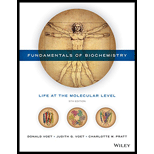
(a)
To calculate: The ΔG value at pH 7.0 for the LDH-catalyzed reduction of pyruvate under the given condition.
Concept introduction: Pyruvate is known as the end product of glycolysis that continues in two different conditions. In aerobic process, it undergoes aerobic respiration; whereas in anaerobic process, it undergoes fermentation. There are two types of fermentation that occurs by pyruvate, one is the lactic acid fermentation and the other one is the alcoholic fermentation.
(b)
To explain: The ΔG value at pH 7.0 for the LDH-catalyzed reduction of pyruvate under the given condition.
Concept introduction: Pyruvate is known as the end product of glycolysis that continues in two different states. In aerobic process, it undergoes aerobic respiration; whereas in anaerobic process, it undergoes fermentation. There are two types of fermentation that occurs by pyruvate, one is the lactic acid fermentation and the other one is the alcoholic fermentation.
(c)
To explain: The ΔG value at pH 7.0 for the LDH-catalyzed reduction of pyruvate under the given condition.
Concept introduction: Pyruvate is known as the end product of glycolysis that continues in two different states. In aerobic process, it undergoes aerobic respiration; whereas in anaerobic process, it undergoes fermentation. There are two types of fermentation that occurs by pyruvate, one is the lactic acid fermentation and the other one is the alcoholic fermentation.
(d)
To explain: The effect of concentration ratios in part a-c on the direction of the reaction.
Concept introduction: Pyruvate is known as the end product of glycolysis that continues in two different states In aerobic process, it undergoes aerobic respiration; whereas in anaerobic process, it undergoes fermentation. There are two types of fermentation that occurs by pyruvate, one is the lactic acid fermentation and the other one is the alcoholic fermentation.
Want to see the full answer?
Check out a sample textbook solution
Chapter 15 Solutions
Fundamentals of Biochemistry: Life at the Molecular Level
 BiochemistryBiochemistryISBN:9781319114671Author:Lubert Stryer, Jeremy M. Berg, John L. Tymoczko, Gregory J. Gatto Jr.Publisher:W. H. Freeman
BiochemistryBiochemistryISBN:9781319114671Author:Lubert Stryer, Jeremy M. Berg, John L. Tymoczko, Gregory J. Gatto Jr.Publisher:W. H. Freeman Lehninger Principles of BiochemistryBiochemistryISBN:9781464126116Author:David L. Nelson, Michael M. CoxPublisher:W. H. Freeman
Lehninger Principles of BiochemistryBiochemistryISBN:9781464126116Author:David L. Nelson, Michael M. CoxPublisher:W. H. Freeman Fundamentals of Biochemistry: Life at the Molecul...BiochemistryISBN:9781118918401Author:Donald Voet, Judith G. Voet, Charlotte W. PrattPublisher:WILEY
Fundamentals of Biochemistry: Life at the Molecul...BiochemistryISBN:9781118918401Author:Donald Voet, Judith G. Voet, Charlotte W. PrattPublisher:WILEY BiochemistryBiochemistryISBN:9781305961135Author:Mary K. Campbell, Shawn O. Farrell, Owen M. McDougalPublisher:Cengage Learning
BiochemistryBiochemistryISBN:9781305961135Author:Mary K. Campbell, Shawn O. Farrell, Owen M. McDougalPublisher:Cengage Learning BiochemistryBiochemistryISBN:9781305577206Author:Reginald H. Garrett, Charles M. GrishamPublisher:Cengage Learning
BiochemistryBiochemistryISBN:9781305577206Author:Reginald H. Garrett, Charles M. GrishamPublisher:Cengage Learning Fundamentals of General, Organic, and Biological ...BiochemistryISBN:9780134015187Author:John E. McMurry, David S. Ballantine, Carl A. Hoeger, Virginia E. PetersonPublisher:PEARSON
Fundamentals of General, Organic, and Biological ...BiochemistryISBN:9780134015187Author:John E. McMurry, David S. Ballantine, Carl A. Hoeger, Virginia E. PetersonPublisher:PEARSON





